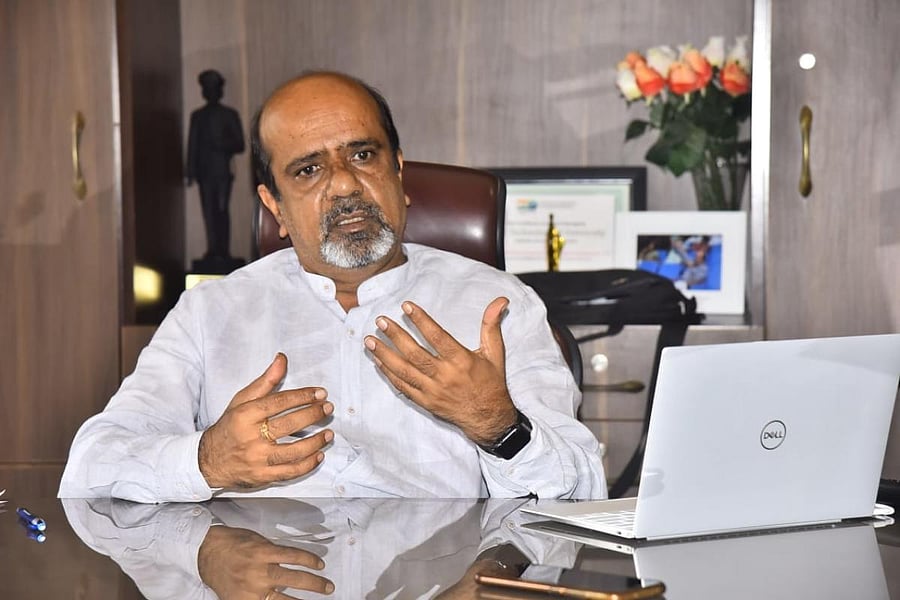
Ashok Shettar, Vice-Chancellor of KLE Technological University, Hubballi, heads a 10-member Special Task Force constituted by Chief Minister Basavaraj Bommai to draft an R&D Policy for Karnataka. He speaks to DH’s Pavan Kumar H on the need to create a robust research ecosystem.
Why does Karnataka need an exclusive R&D Policy?
For the first time in India, a state is coming up with its own comprehensive R&D policy. No doubt, the Union government largely supports research. But it is imperative to create a regional ecosystem that can drive research and innovation that can, in turn, boost socio-economic development.
Karnataka, primarily Bengaluru, leads the research ecosystem in India, largely due to its legacy. However, even in this era of the knowledge economy, research mostly is viewed in isolation. Research happening in labs has little focus on society’s problems. The policy aims to improve the lives of people through research and innovation.
There are a large number of actors associated with this—higher education institutions, public sector labs, private enterprises, MSMEs, entrepreneurs and individuals. For any impactful research to happen, all these actors have to come together. The new policy will direct the formulation of some structures to address this. It will look beyond just IT and will take innovation to address issues of primary sectors like agriculture, health, water management and environment.
What will be the role of the government in implementing the policy?
Government is an important player that can act as an enabler here. If Atmanirbhar Bharat has to happen and we have to come up with products that are competitive at the global level, we need research and innovation of high class. For this, the government must drive all the actors toward an ‘innovation’ goal. This policy defines the government’s role and also the participation of other actors.
Is India/Karnataka spending enough on R&D?
Unfortunately, in India, our investment and our support system are not adequate at this point of time. India spends around 0.7 per cent of its GDP on research and innovation whereas the worldwide average is 2.5 per cent. Countries like Korea and Japan that have technologically transformed in recent decades invest nearly 4.5 per cent of their GDP.
Of the total allocation, India spends 70 per cent of funds on research in defence and public sector organisations such as DRDO and ISRO, and just 30 per cent on other researchers.
When it comes to the state, hardly anything is spent on research. Only 0.01 per cent of GDP is spent on research and this is also spent across departments that rarely function in a coordinated manner. So, I feel states should also invest substantially in research and have a coordinated effort. This, in the long run, will decide the competitiveness of the state. Without investing today, we are not going to progress tomorrow.
Which are the sectors that you think Karnataka is lagging in when it comes to R&D? What are the focus areas for the policy?
Karnataka presently needs to focus on hardware and electronics. But development in hardware will be of help only if it connects to things like applications. So, the challenge before us is to create applications so that people directly benefit from them. For instance, how advanced technologies like IoT can be applied to improve agriculture productivity, reduce agriculture losses, connect farmers to the market across the country, make predictive price analysis and at the same time better our water supply system and control pollution.
The next thing is manufacturing. Compared to other states, Karnataka lags in the traditional manufacturing sector. But we have an opportunity to exploit the new-age manufacturing sector that is heavily driven by technology, such as electric vehicles. We can transform the scenario of our manufacturing sector through automation, robotics, AI and so on.
How are you going to involve the private sector in it, especially in terms of funding?
Investment by the private sector in research is going to grow in the coming years. In developed countries, 60-70 per cent of research funding happens from the private sector. But this happens only when a stage of maturity is reached in research. Initially, substantial investment should come from the government and subsequently, the private sector will pitch in.
The policy talks of a PPP model in research. But the private sector will invest based on talent rather than just infrastructure and equipment. So, talent development is more important. Most of our PHDs go into academics and not to the industry. So, the policy talks about attracting researchers to the industry as well.
Also, the priority sector needs to be supported to act dynamically, based on challenges. At present, except for the health/pharma sector, there is little investment by the private sector in agriculture, environment and others. So, there is a need to take up mission-oriented research. For instance, improving soil health can be mission research, or finding medicines for Covid.
Not many students are going into research work in recent years. How do you address this issue?
We lose our top talent after undergraduate studies as they turn to jobs due to the absence of a defined career goal in the academic research sector. We can expect top talent in the research sector only when there is the mobility of talent between industry and academia. This can be done by offering internships for our researchers in the industry and enhancing scholarships.
Watch the latest DH Videos here: